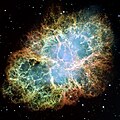File:Crab Nebula.jpg
Vai alla navigazione
Vai alla ricerca

Dimensioni di questa anteprima: 600 × 600 pixel. Altre risoluzioni: 240 × 240 pixel | 480 × 480 pixel | 768 × 768 pixel | 1 024 × 1 024 pixel | 2 048 × 2 048 pixel | 3 864 × 3 864 pixel.
File originale (3 864 × 3 864 pixel, dimensione del file: 13,84 MB, tipo MIME: image/jpeg)
Cronologia del file
Fare clic su un gruppo data/ora per vedere il file come si presentava nel momento indicato.
| Data/Ora | Miniatura | Dimensioni | Utente | Commento | |
|---|---|---|---|---|---|
| attuale | 15:56, 25 nov 2012 |  | 3 864 × 3 864 (13,84 MB) | Hawky.diddiz | Lossless optimization |
| 11:13, 17 mag 2012 |  | 3 864 × 3 864 (14,61 MB) | Metrónomo | Higher quality | |
| 10:31, 20 giu 2009 |  | 3 864 × 3 864 (6,18 MB) | Tryphon | Higher resolution. | |
| 22:26, 9 mar 2006 |  | 2 224 × 2 212 (3,08 MB) | Stianbh | larger version | |
| 01:35, 16 gen 2006 |  | 400 × 400 (23 KB) | DragonFire1024 | Image: A New View of the Helix Nebula Source: http://hubblesite.org/gallery/album/entire_collection/pr2004032d/ Copyright Notice: Material credited to STScI on this site was created, authored, and/or prepared for NASA under Contract NAS5-26555. Unless |
Pagine che usano questo file
Più di 100 pagine usano questo file. Di seguito sono elencate solo le prime 100 pagine che usano questo file. È disponibile un elenco completo.
- Ammasso Farfalla
- Ammasso Globulare di Ercole
- Astronomia
- Catalogo di Messier
- Evoluzione stellare
- Galassia Fuso
- Galassia Girandola
- Galassia Girandola del Sud
- Galassia Occhio Nero
- Galassia Sigaro
- Galassia Sombrero
- Galassia Virgo A
- Galassia del Triangolo
- Galassia di Andromeda
- Galassia di Bode
- M100
- M102
- M106
- M10 (astronomia)
- M110 (astronomia)
- M11 (astronomia)
- M12 (astronomia)
- M14 (astronomia)
- M15 (astronomia)
- M18 (astronomia)
- M19 (astronomia)
- M21 (astronomia)
- M22 (astronomia)
- M23 (astronomia)
- M25 (astronomia)
- M26 (astronomia)
- M28 (astronomia)
- M29 (astronomia)
- M2 (astronomia)
- M30 (astronomia)
- M32 (astronomia)
- M34 (astronomia)
- M35 (astronomia)
- M36 (astronomia)
- M37 (astronomia)
- M38 (astronomia)
- M39 (astronomia)
- M3 (astronomia)
- M40 (astronomia)
- M41 (astronomia)
- M46 (astronomia)
- M47 (astronomia)
- M48 (astronomia)
- M49 (astronomia)
- M4 (astronomia)
- M50 (astronomia)
- M51 (astronomia)
- M52 (astronomia)
- M53 (astronomia)
- M54 (astronomia)
- M55 (astronomia)
- M59 (astronomia)
- M5 (astronomia)
- M60 (astronomia)
- M62 (astronomia)
- M65 (astronomia)
- M66 (astronomia)
- M67 (astronomia)
- M70 (astronomia)
- M72 (astronomia)
- M74 (astronomia)
- M75 (astronomia)
- M76 (astronomia)
- M77 (astronomia)
- M78 (astronomia)
- M79 (astronomia)
- M7 (astronomia)
- M80 (astronomia)
- M84 (astronomia)
- M85 (astronomia)
- M86 (astronomia)
- M88 (astronomia)
- M89 (astronomia)
- M90 (astronomia)
- M92 (astronomia)
- M93 (astronomia)
- M95 (astronomia)
- M96 (astronomia)
- M99 (astronomia)
- M9 (astronomia)
- Nebulosa
- Nebulosa Anello
- Nebulosa Civetta
- Nebulosa De Mairan
- Nebulosa Granchio
- Nebulosa Laguna
- Nebulosa Manubrio
- Nebulosa Omega
- Nebulosa Trifida
- Nebulosa di Orione
- Nube stellare del Sagittario
- Presepe (astronomia)
- Resto di supernova
- Stella
- Stella variabile
Visualizza altri collegamenti a questo file.
Utilizzo globale del file
Anche i seguenti wiki usano questo file:
- Usato nelle seguenti pagine di af.wikipedia.org:
- 1054
- Wikipedia:Uitgesoekte herdenkings/22 April
- Wikipedia:Uitgesoekte herdenkings/Julie
- Wikipedia:Uitgesoekte herdenkings/April
- Wikipedia:Uitgesoekte herdenkings/4 Julie
- Supernova
- Ster
- Wikipedia:Beeld van die week/2012
- Wikipedia:Voorbladbeeld week 2 2012
- Newel
- Kompakte ster
- Veranderlike ster
- Lys van Messier-voorwerpe
- Krapnewel
- Portaal:Sterrekunde/Inleiding
- Portaal:Sterrekunde
- Hemelliggaam
- Lys van planetêre newels
- SN 1054
- Supernova-oorblyfsel
- Sterevolusie
- Usato nelle seguenti pagine di als.wikipedia.org:
- Usato nelle seguenti pagine di am.wikipedia.org:
- Usato nelle seguenti pagine di anp.wikipedia.org:
- Usato nelle seguenti pagine di ar.wikipedia.org:
- مجرة
- نجم
- سنة
- تطور النجوم
- ثلاثي الكربون
- فجر
- مستعر أعظم
- بوابة:علم الفلك/مقالة مختارة
- شهاب
- مطلع مستقيم
- جمعية منسا الدولية
- علم الفلك خارج المجري
- عنقود نجمي
- فيلا (أقمار اصطناعية)
- الشلياق
- خرزات بيلي
- راية الأرض
- سمت
- نظرية الحالة الثابتة
- توهج القمر الصناعي
- بوابة:الفيزياء/بوابات ذات علاقة
- الظهر
- اقتران (علم الفلك)
- علم الهيئة
- مقراب راديوي
Visualizza l'utilizzo globale di questo file.

